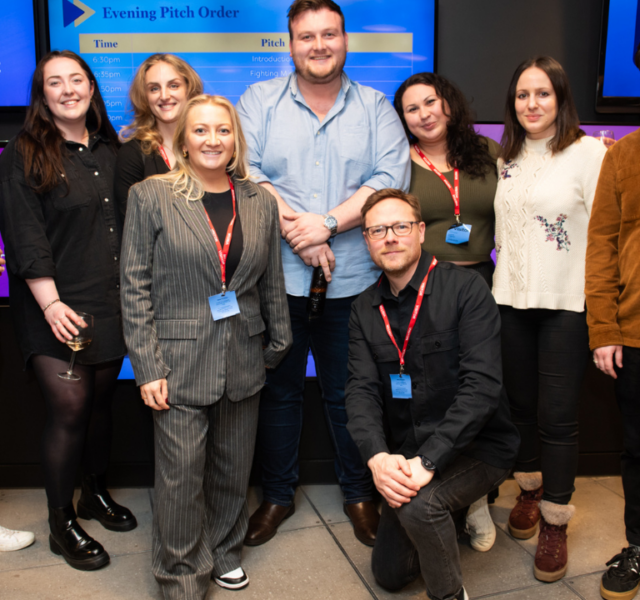Fast Forward
Run by NABS for over 20 years, Fast Forward has helped hundreds of future leaders find their voice and their path.
What is Fast Forward?
Fast Forward is a six-week pitch training course in February - March 2026 that helps you grow your skills, thinking, and network. You'll work in a team to tackle a live brief focused on a real-world social issue - building strategy, crafting ideas, and sharpening your storytelling as you go. With guidance from top industry voices and support from a team mentor, you'll bring everything together in a final pitch that puts your learning into action.
Book Fast Forward 2026
Who is Fast Forward for?
The Fast Forward programme will most benefit professionals from the advertising and media industry -whether from media owners, media agencies, tech companies, or creative agencies- who are junior to mid-level talent with one to five years’ experience. With over 1600 rising stars trained, you’re in good company.
What you'll learn
With guidance from top industry voices and support from a team mentors, you'll bring everything together in a final pitch that puts your learning into action
The Fast Forward programme
Week one: The brief & insights
Client presents the brief on launch night.
Speaker session: 'Insight' is perhaps the most overused word in marketing. But, when you think about it, are you actually clear on what an insight is? This talk hopes to provide an answer to that question and, more importantly, it hopes to provide some practical advice on how you can find insights in the future. You won't just get an abstract list of principles though- each suggestion is explained in the context of real work that delivered in the real world. We'll cover everything from Yorkshire to The Guardian and there'll be plenty of time for a good chat at the end.
Online working session with team.
Week two: Connections and Storytelling
Speaker sessions:
Connections - The world of media planning might have become more complex with channels and consumption fragmenting at the rate of knots but at its heart, it remains unchanged. Its about understanding people and the way that a brand needs to reach them to encourage action. In this session, we will explore the fundamentals of planning to enable you to create an exciting but most importantly effective media plan.
Storytelling and How to Respond - Media channel planning, prioritising different channels to reach target audience from insights, and learn all about storytelling and how to craft the narrative of a response to a brief.
Online or in-person working session with team.
Week three: what makes a good idea?
Speaker session: Great ideas are the lifeblood of our industry. They create unfair advantage for our clients and are the heart of how media can connect with audiences. But at the same time coming up with powerful ideas can be an equally intimidating and nebulous affair. This session will help define what we mean by an idea, what good looks like, and how to finally stop worrying about having them.
In-person working session with team.
Week four: your tissue session & how to pitch
Tissue session with the client to check your ideas match their expectation.
Speaker session: Top tips on how to pitch – the little details that make all the difference.
In-person working session with team.
Week five: your pitch
Online or in-person working session with team.
Pitch rehearsals.
Pitch night - Present your pitch to the judging panel and fellow delegates.
Online or in-person working session with team.
Week six: winning (& losing) & why
Results night
Win or lose, leave with extensive knowledge you didn't think you could learn in just six weeks along with lifetimes connections to others in the industry.
Winners Announcement
After a final pitch judged by the client and senior industry figures, the winners are revealed
What delegates say about Fast Forward
I can't recommend it enough. It's more than a course; it's a transformative experience that creates lifelong friendships and growth Iman Sid, Fast Forward 2024 winner
The opportunity to talk in front of such senior clients and senior judges was incredible. Oscar Beach, Fast Forward 2024 delegate
A jam-packed six weeks where I learned so much beyond the scope of my usual role. It’s an amazing course for anyone looking to advance their career, Fast Forward 2025 delegate
Watch highlights from Fast Forward
What mentors say about Fast Forward
The delegates were great, the experience was so rewarding and it actually energised me, reminded me why I am in media and love pitching. Fast Forward 2025 Mentor
Such a good chance to work with a range of people across the industry Fast Forward 2025 Mentor
It's so rewarding to identify the superstar or two in the group and see them develop over such a short space of time. Fast Forward 2025 Mentor



Benefits of Fast Forward:
- Reward or incentivise staff and increase retention.
- Delegates gain invaluable experience working on a live brief from a topical social issue client in a competitive pitch process.
- Delegates meet a new network from across the industry.
- The course includes vital content on supporting mental wellness, shaped by NABS’ unique insights.
- All profits go back to helping NABS support our community.
- IPA-accredited training time.
When is Fast Forward 2026?
Fast Forward 2026 kicks off on 17th February and runs until 24th March 2026.
This site is protected by reCAPTCHA and the Google Privacy Policy and Terms of Service apply.
